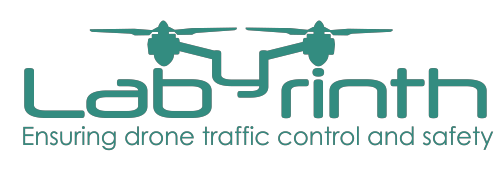This June saw the launch of the European LABYRINTH project. The aim of LABYRINTH is to build on the high optimisation potential for the management and supervision processes of unmanned aerial systems to optimise drone traffic, and thus enhance and encourage its use in high-density areas.
LABYRINTH will focus on providing a drone traffic service to improve the safety and efficiency of civil land, sea, and air transport, as well as improving emergency and rescue operations.
 This ambitious project has received €4 957 076,25 funding from the European Union’s Horizon 2020 research and innovation programme under grant agreement No 861696. It will be undertaken over 36 months by 13 European entities at the forefront of the transport, aviation, research, emergency, and ancillary services sectors.
This ambitious project has received €4 957 076,25 funding from the European Union’s Horizon 2020 research and innovation programme under grant agreement No 861696. It will be undertaken over 36 months by 13 European entities at the forefront of the transport, aviation, research, emergency, and ancillary services sectors.
These organisations will investigate the design of applications and procedures that will revolutionise the transport of drones and accelerate the regulatory changes needed to allow drone use in the European Union.
Why LABYRINTH?
Drones can be a great benefit to society, thanks to their many abilities including delivery, surveillance or management operations, or accessing hard-to-reach places in emergencies, but to date safety and security concerns have limited their use and it is often illegal to fly them in public areas. However, it is estimated that by 2035 there will be around 400,000 unmanned aircraft flying in Europe. The challenge will be to safely manage drone traffic in cities and other areas sensitive to congestion.
Ensuring the safety and efficiency of transport is one of the EU’s main priorities. The SESAR (Single European Sky ATM Research) programme is leading the development of U-Space, to create a new air traffic management framework that includes drones. This new framework is designed to integrate low-level drone operations, below 120 metres (400ft), safely and efficiently into the European airspace.
To work towards this, LABYRINTH will produce a centralised planning system capable of communicating with all drones active in a given airspace volume, and by identifying their directional layout to avoid collisions by calculating alternative routes where necessary. LABYRINTH will base its technology on the U-Space framework and progress the work already done within the SESAR strategy,
Potential LABYRINTH applications
This project intends to develop applications capable of revolutionising air transport and accelerating regulatory changes regarding drone use in the EU. This progress offers a huge range of applications and new business models that open the drone industry to new markets.
LABYRINTH is focused on offering its services to public or private entities responsible for managing land, sea, and air transport infrastructures, as well as emergency and rescue operations. LABYRINTH will enable a wide range of drone operations for each of the above fields:
- Air transport: identifying birds that may interfere with air traffic, verifying airport infrastructures, preventing unauthorised personnel or drones from accessing sensitive areas of an airport, etc..
- Land transport: speed control, number-plate recognition, traffic supervision, management in case of accidents, alleviation of traffic congestion, etc..
- Maritime transport: port traffic monitoring, facility supervision, monitoring dredging operations to ensure operational areas of navigation, etc..
- Emergencies: surveillance and study of an area to identify escape routes and medical assistance points, provision of important warnings in real time, etc.
The Consortium
LABYRINTH will be undertaken by 13 European entities from Spain, Germany, Austria, Italy, and Belgium. These entities are experts in the different sectors involved in the project: transport, aviation, research, emergency, and ancillary services.
The entities are:
UC3M – University Carlos III of Madrid
DLR – The German Aerospace Centre
DGT – Directorate General for Traffic
TID – Telefonica Research and Development
INTA – International Institute for Aerospace Technology
Eurocontrol – Organization for the Safety of Navigation,
DIN – German Institute for Standardization
The Authority of the Port System of the Eastern Ligure Sea
AIT – Austrian Institute of Technology
Madrid City Council – SAMUR Civil Protection
Source: Press Release

